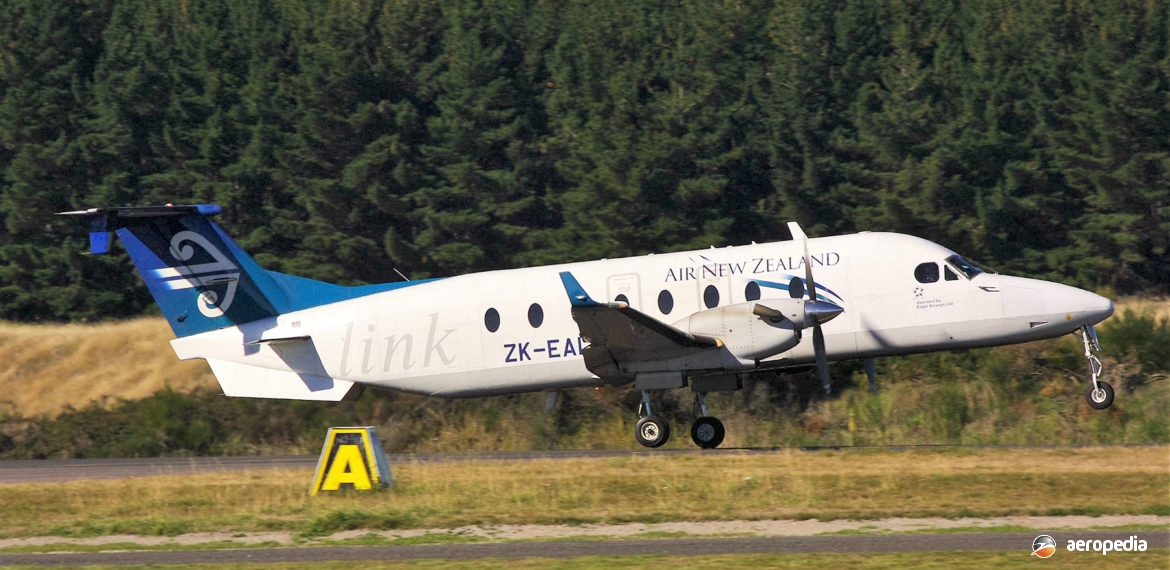Photograph:
Beech 1900D ZK-EAL (c/n UE-435) at Taupo, NZ in May 2012 (David C Eyre)
Country of origin:
United States of America
Description:
Commuter airliner
Power Plant:
Two 954 kw (1,279 shp) Pratt & Whitney PT6A-67 turboprops
Specifications:
- Wingspan: 17.67 m (58 ft)
- Length: 17.63 m (57 ft 10 in)
- Height: 4.72 m (15 ft 6 in)
- Wing area: 28.8 m² (310.0 sq ft)
- Max cruising speed at 3,048 m (10,000 ft): 520 km/h (323 mph)
- Cruising speed at 6,096 m (20,000 ft): 528 km/h (328 mph)
- Stalling speed: 152 km/h (94 mph)
- Take-off field length: 1,544 m (5,067 ft)
- Rate of climb at sea level: 800 m/min (2,625 ft/min)
- Single engine climb rate: 206 m/min (675 ft/min)
- Service ceiling: 10,058 m (33,000 ft)
- Max certificated altitude: 7,620 m (25,000 ft)
- Range with ten passengers and reserves at economical cruising speed: 2,776 km (4,467 km)
- Range with 19 passengers at 2,440 m (8,000 ft): 926 km (575 miles)
- Empty weight: 4,717 kg (10,400 lb)
- Max payload: 2,087 kg (4,600 lb)
- Loaded weight: 7,688 kg (16,950 lb)
History:
At the conference of the United States Regional Airlines Association in 1989 Beech announced it would produce a new variant of the 1900C known as the 1900D. The new model was a major re-design of the earlier 1900C to meet US FAR Part 23 commuter category regulations which took effect in October 1991. Cabin height was increased to 1.8 m (5 ft 10 in), except for a ramp over the wing carry through which reduced height in that area to 1.65 m (5 ft 5 in).
One of the design targets was to be able to carry a full complement of 19 passengers plus all baggage at the one time, this requiring more powerful engines and a wider centre of gravity range, this entailing a re-designed tail. The rear baggage compartment was 4.97 m³ (175.5 sq ft) and could accommodate 740 kg (1,631 lb) of baggage.
A T-tail was chosen to keep the horizontal stabiliser in less disturbed air and out of the downwash of the propellers. This involved increasing tailplane area and mounting small horizontal surfaces called ‘stabilons’ on the sides of the fuselage to the rear of the cargo door. Power was provided by two Pratt & Whitney PT6A-67D turbines de-rated from 1,203 kw (1,613 shp) to 954 kw (1,279 shp).
The prototype 1900D first flew on 1 March 1990 and first aircraft delivered was to Mesa Air in November 1991, this airline placing an order for 118 aircraft. More than 500 were built.
In 1991 the Model 1900D received certification, the cabin being 36 cm (14.17 in) taller than the 1900C, and accommodation was provided for up to 19 passengers.
The first major operator of the type in this region initially was Impulse Airlines, operating mainly in New South Wales with a fleet of 13 examples of the type, initially 1900Cs and later 1900Ds, including: VH-MML (c/n UE-10), VH-NBN² (c/n UE-318), VH-IMQ (c/n UE-273), VH-IMR (c/n UE-324), VH-IMS (c/n UE-214), VH-AFR (c/n UE-200), VH-IMA (UE-7), VH-IMH (c/n UE-230), VH-NKN (c/n UE-325), VH-NTL (c/n UE-117), VH-IPB (c/n UE-117), VH-SMH (c/n UE-191), and VH-FOZ (c/n UE-360).
First of the type seen in Australia was VH-SMH imported by Impulse Airlines to meet commitments to the John Fairfax newspaper group for print distribution in the north west of New South Wales and south-west Queensland. It was painted in the markings of the Sydney Morning Herald newspaper, a second aircraft being obtained to meet commitments for routes to Melbourne, VIC, Adelaide, SA and Canberra, ACT.
In 2001 Impulse Airlines ceased services and was acquired by Qantas, the 1900Ds continuing to operate with Qantas Link/Air Connex but still in Impulse colours for a period until 2002 when the fleet was withdrawn. In later times the type has been used on freight work but most were subsequently exported.
Further operators have included Emu Airways with 1900C1s VH-EMI (c/n UC-109) and VH-EMK (c/n UC-159), and Air Link had a 1900D VH-RUE (c/n UE-53). A few examples have also been used on night freight operations.
Production of the 1900C concluded in 1991, giving way to the 1900D. Cruising at 537 km/h (334 mph) and carrying 19 passengers, it had a range of 1,300 km (807 miles) with a 185 km (115 miles) alternate destination range and 45 minutes reserve. At one stage inn lagte 1999 it was announced the RAAF would obtain four Beech 1900Ds to replace the Hawker Siddeley HS-748 navigation trainers.
Further operators have obtained examples of the type. Eagle Airways in New Zealand imported and commenced operating 1900Ds, the first two aircraft becoming ZK-EAA (c/n UE-424) and ZK-EAB (c/n UE-425), these being operated in Air New Zealand Link colours. Subsequent aircraft included: ZK-EAC (c/n UE-426), ZK-EAD (c/n UE-427), ZK-EAE (c/n UE-428), ZK-EAF (c/n UE-429), ZK-EAG (c/n UE-430), ZK-EAH (c/n UE-431), ZK-EAI (c/n UE-432), ZK-EAJ (c/n UE-433), ZK-EAK (c/n 434), ZK-EAL (c/n UE-435), ZK-EAM (c/n UE-436), ZK-EAN (c/n UE-437), ZK-EAO (c/n UE-438) and ZK-EAP (c/n UE-439).
On 11 November 2014 Air New Zealand announced it would cease operating its fleet of Beech 1900D aircraft (operated by subsidiary Eagle Air) from its Hamilton base by August 2016 and would purchase four additional ATR-72s to service the routes that had been operated by the 1900Ds. The fleet was sold, a few being exported to Australia where they took up temporary Australian registrations before being further exported.

